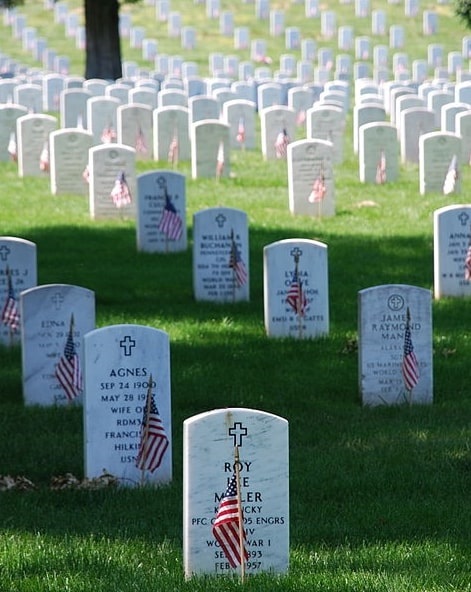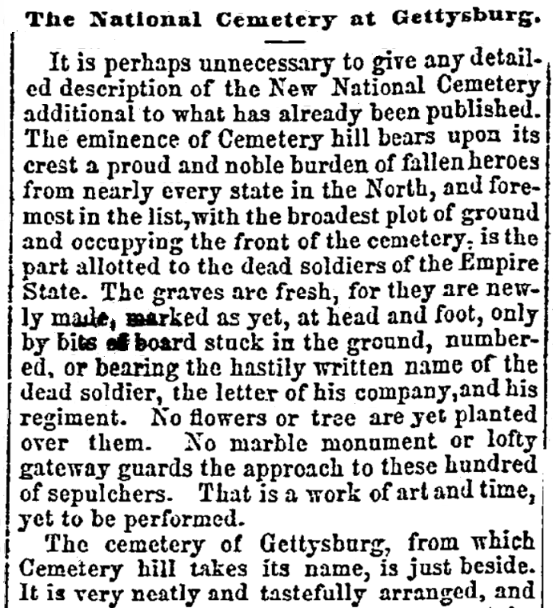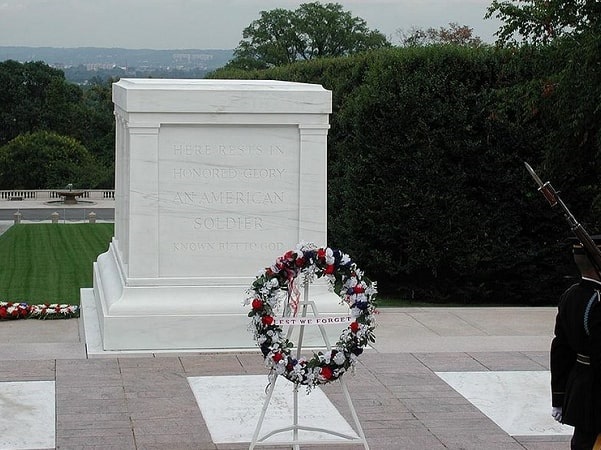Introduction: In this article – to help commemorate Memorial Day next Monday – Gena Philibert-Ortega describes where your veteran ancestor might be buried. Gena is a genealogist and author of the book “From the Family Kitchen.”
When we think of military burials, we automatically consider national cemeteries – with good reason. These military cemeteries are the sacred burial grounds for military veterans, their spouses, and dependent children. However, while national cemeteries are exclusively for the military, not all soldiers and sailors are buried there.

A Short History of Military Cemeteries
National cemeteries have their origins in the American Civil War era (1861-1865). These cemeteries were created as early as 1862 and “Following the conclusion of hostilities in April 1865, the U.S. Army Quartermaster General’s Office planned additional national cemeteries at sites of major battles, prison of war locations, and hospitals.” (1)
Obviously, there were military dead prior to the American Civil War and the federal government did facilitate burials in cemeteries established in places like forts. The government also took advantage of available space in private cemeteries, establishing Soldier’s Lots where military personnel were buried. Today these spaces are recognizable with their clusters of government-issued grave markers and memorials.

National cemeteries expanded during the years between the Civil War and World War II. Cemeteries were established to meet the needs of veterans and to accommodate World War II service members. (2) In 1973 the cemetery system was taken over from the Army by the Department of Veteran Affairs. Cemeteries continued to be established into the 2000s.
U.S. military cemeteries also exist in foreign countries and were established to bury those who died during service in World War I and World War II. To learn more and search their database see the American Battle Monuments website.
Military Burials
National cemeteries are one place where military dead are buried. However, there are numerous reasons why an active-duty military member or a veteran would not be buried in a national cemetery. These reasons could include:
- Deceased was cremated and the family retained the ashes or they were scattered.
- The deceased’s body was not recovered.
- Surviving family chose to bury their loved one at a cemetery closer to where they lived.
- Deceased was buried near where they passed away.
- Deceased’s body was not claimed and/or their veteran status was not known. Burial may have been in a potter’s field.
Because a veteran could be buried in any number of places, keep in mind that you can find military burials in non-military cemeteries. Military personnel may be buried in a special military section of a non-military cemetery with their families. They may or may not have a government-issued headstone.
One place to look for a military burial is the Nationwide Gravesite Locator. Available on the U.S. Department of Veteran Affairs website, the database is searchable by a name and includes burials in “VA national cemeteries, state veterans cemeteries, various other military and Department of Interior cemeteries, and for Veterans buried in private cemeteries when the grave is marked with a government grave marker.” (3) This is a first place to begin your search if you don’t know where the veteran is buried. However, don’t give up your search if you don’t find what you are looking for.
A quick search for my 2nd great uncle Joseph Chatham, who is buried in a private cemetery and has a government grave marker, confirmed that he is not listed in this directory. Reading the web page “About NGL” uncovers the reason why:
…[information about] Veterans buried in private cemeteries was collected for the purpose of furnishing government grave markers and we do not have information available for burials prior to 1997.
Joseph died in 1956, four decades before 1997. Knowing this, I needed to use other means to find his burial. His burial place was not included in this database or his obituary, but it was on his death certificate.
Genealogy Tip: Sometimes the information you need is found by utilizing more than one record that records a person’s death.
A private cemetery may have a special section for military burials but that doesn’t mean the veteran you are looking for is buried there. Make sure to contact the cemetery office (if there is one) to ascertain the exact location of the burial place. Veterans may be buried anywhere in the cemetery, not just in a specific section.
Memorial Day 2024
Do you know a veteran whose grave is unmarked or who is in need of a government-issued headstone? You can apply to have their grave marked through the Department of Veteran Affairs. Information on eligibility and the process is found on their website.
Memorial Day is a special day to remember deceased veterans. Locating their burial place is one way to do that. Whether you use their death certificate, obituary, or an online grave locator, seek out death information that can help you add to the story of their lives.
Explore over 330 years of newspapers and historical records in GenealogyBank. Discover your family story! Start a 7-Day Free Trial
Note on the header image: the Tomb of the Unknown Soldier located in Arlington National Cemetery, Virginia. Credit: Raul654; Wikimedia Commons.
Related Articles:
- Genealogy 101: Veterans Cemeteries
- Genealogy Tip: What Does a Gravestone Tell Us?
- Genealogy Tip: What a Gravestone Tells Us – Grave Markers
_______________
(1) “Dates of Establishment: National Cemeteries & NCA Burial Sites (1 of 6),” Department of Veteran Affairs (https://www.cem.va.gov/facts/Dates_of_Establishment_1.asp: accessed 14 May 2024).
(2) Ibid.
(3) “Nationwide Gravesite Locator,” Department of Veteran Affairs (https://www.cem.va.gov/nationwide-gravesite-locator/: accessed 14 May 2024).
